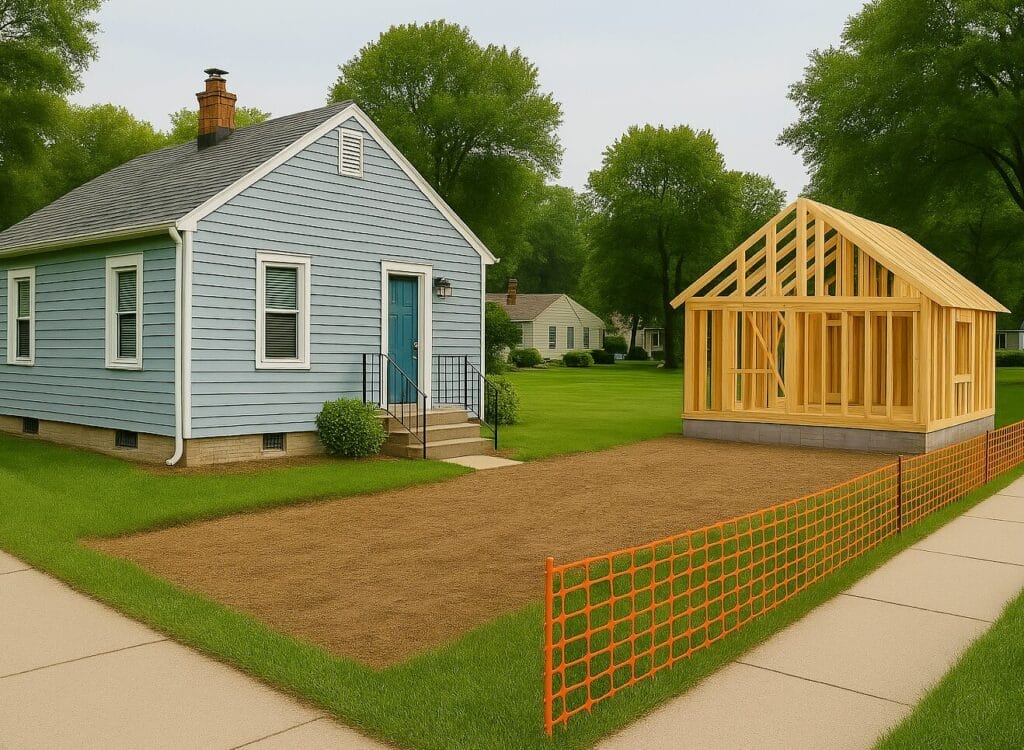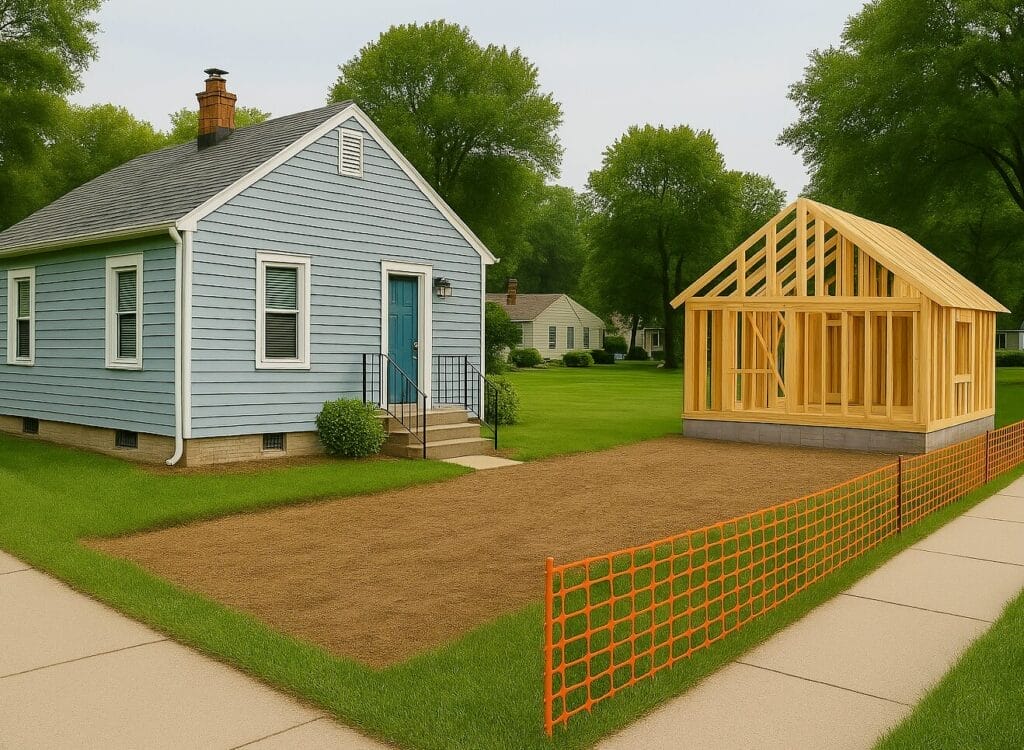This post originally appeared at https://www.badgerinstitute.org/wisconsin-cities-can-grow-if-they-let-housing-markets-work-say-scholars/
Study from AEI calculates more than 21,000 new homes a year from permitting economically feasible urban infill
Concerned that exorbitant housing is out of reach for middle-class families, cities without developable green-field sites could ease the squeeze by allowing more market-driven urban infill, say scholars at the American Enterprise Institute.

“Why is housing so expensive?” asks Ed Pinto, co-director of the Housing Center at AEI in Washington, D.C. It’s because, he says, costly housing is all that most cities will allow a developer to build, even inside urban areas.
The AEI scholars have modeled three options for infill development in Wisconsin urban areas that, they calculate, could mean more than 21,000 new homes per year in the state, all without government subsidies or mandates.
“The point is that you have to allow things that are economically viable,” said Pinto.
One option is to allow people with a house on a lot to build an accessory dwelling unit — also called a “granny flat” or an “in-law suite,” either attached to the back of the house or as a separate building. AEI’s model, which uses the actual house prices and sizes of existing lots in Wisconsin cities, reckons that perhaps as many as 5,100 such units would make economic sense per year.
Another option recognizes the fact that many old houses are on large lots in or near cities where the value of land has now outpaced that of the house. In some cases, the land value constitutes 60% or more of the total value, much higher than 30% that lenders and builders regard as a rule of thumb. For some houses, the AEI model calculates, it makes more sense for a homeowner who is looking to sell to subdivide the lot into several city-sized lots, each with a single-family home.
Pinto’s team calculates that if such an option were available in all the places in Wisconsin where it makes economic sense, it could mean as many as 6,500 new houses annually, if cities permitted it. Often they don’t, in part because neighbors want to keep the look of their surroundings intact.
But, wrote Pinto and colleagues in a 2022 book explaining their “light-touch density” concepts, “Preventing change in a neighborhood is generally impossible. If land use regulations prevent the built form from changing, the neighborhood community will change nonetheless,” as homeowners age and leave. The main alternative to subdividing an expensive large lot, he points out, is a teardown of the 1950s ranch and its replacement with a “McMansion,” much larger and out of character with the neighbors anyway.
“Nobody would put a $600,000 structure on a million-dollar lot,” he says. “It would be uneconomical the day it was built,” and so lenders would balk.
His team includes a map of census tracts in Wisconsin where existing land and home values make the neighborhood especially vulnerable to McMansions. One part of Madison near Lake Wingra has, by AEI’s calculation, 168 houses vulnerable to such replacement when sold; four already have been replaced by much larger, costlier houses. Teardowns may pencil out, but they change a neighborhood — and, Pinto points out, don’t provide much new housing.
A third option, what Pinto dubs “livable urban villages,” involves simply making it always permissible to add residential use, including single-family home, duplexes, and larger apartment buildings, in existing commercial or industrial districts of a city. The idea is to permit the free market to find the next example of what has happened to Milwaukee’s Third Ward. This could lead to as many as 10,000 new homes annually.
“We’re not saying you have to building housing there,” Pinto says. “But if someone comes along and says, ‘Wait a minute — I believe that parcel’s highest and best use is housing,’ and wants to build housing, let them, simple as that, by right.”
“By right” means that, once zoning and other building rules for a parcel are set into code, developers need no more permission for a project. It’s important, says Pinto, to giving builders some certainty of a project going forward once they’ve committed money to planning it.
The three urban options are in addition to the biggest suggestion in AEI’s playbook for Wisconsin, letting builders offer smaller lots on green-field sites. That idea — allowing mostly single-family homes at about 6 homes per acre instead of the 3.5 per acre that Wisconsin has averaged since 2000, along with some townhouse-style single-family homes — could mean about 31,000 additional homes a year on no more land than we’re currently using for development.
Patrick McIlheran is the Director of Policy at the Badger Institute.
Any use or reproduction of Badger Institute articles or photographs requires prior written permission. To request permission to post articles on a website or print copies for distribution, contact Badger Institute President Mike Nichols at mike@badgerinstitute.org or 262-389-8239.
var gform;gform||(document.addEventListener(“gform_main_scripts_loaded”,function(){gform.scriptsLoaded=!0}),document.addEventListener(“gform/theme/scripts_loaded”,function(){gform.themeScriptsLoaded=!0}),window.addEventListener(“DOMContentLoaded”,function(){gform.domLoaded=!0}),gform={domLoaded:!1,scriptsLoaded:!1,themeScriptsLoaded:!1,isFormEditor:()=>”function”==typeof InitializeEditor,callIfLoaded:function(o){return!(!gform.domLoaded||!gform.scriptsLoaded||!gform.themeScriptsLoaded&&!gform.isFormEditor()||(gform.isFormEditor()&&console.warn(“The use of gform.initializeOnLoaded() is deprecated in the form editor context and will be removed in Gravity Forms 3.1.”),o(),0))},initializeOnLoaded:function(o){gform.callIfLoaded(o)||(document.addEventListener(“gform_main_scripts_loaded”,()=>{gform.scriptsLoaded=!0,gform.callIfLoaded(o)}),document.addEventListener(“gform/theme/scripts_loaded”,()=>{gform.themeScriptsLoaded=!0,gform.callIfLoaded(o)}),window.addEventListener(“DOMContentLoaded”,()=>{gform.domLoaded=!0,gform.callIfLoaded(o)}))},hooks:{action:{},filter:{}},addAction:function(o,r,e,t){gform.addHook(“action”,o,r,e,t)},addFilter:function(o,r,e,t){gform.addHook(“filter”,o,r,e,t)},doAction:function(o){gform.doHook(“action”,o,arguments)},applyFilters:function(o){return gform.doHook(“filter”,o,arguments)},removeAction:function(o,r){gform.removeHook(“action”,o,r)},removeFilter:function(o,r,e){gform.removeHook(“filter”,o,r,e)},addHook:function(o,r,e,t,n){null==gform.hooks[o][r]&&(gform.hooks[o][r]=[]);var d=gform.hooks[o][r];null==n&&(n=r+”_”+d.length),gform.hooks[o][r].push({tag:n,callable:e,priority:t=null==t?10:t})},doHook:function(r,o,e){var t;if(e=Array.prototype.slice.call(e,1),null!=gform.hooks[r][o]&&((o=gform.hooks[r][o]).sort(function(o,r){return o.priority-r.priority}),o.forEach(function(o){“function”!=typeof(t=o.callable)&&(t=window[t]),”action”==r?t.apply(null,e):e[0]=t.apply(null,e)})),”filter”==r)return e[0]},removeHook:function(o,r,t,n){var e;null!=gform.hooks[o][r]&&(e=(e=gform.hooks[o][r]).filter(function(o,r,e){return!!(null!=n&&n!=o.tag||null!=t&&t!=o.priority)}),gform.hooks[o][r]=e)}});
Submit a comment
“*” indicates required fields
/* = 0;if(!is_postback){return;}var form_content = jQuery(this).contents().find(‘#gform_wrapper_21’);var is_confirmation = jQuery(this).contents().find(‘#gform_confirmation_wrapper_21’).length > 0;var is_redirect = contents.indexOf(‘gformRedirect(){‘) >= 0;var is_form = form_content.length > 0 && ! is_redirect && ! is_confirmation;var mt = parseInt(jQuery(‘html’).css(‘margin-top’), 10) + parseInt(jQuery(‘body’).css(‘margin-top’), 10) + 100;if(is_form){jQuery(‘#gform_wrapper_21’).html(form_content.html());if(form_content.hasClass(‘gform_validation_error’)){jQuery(‘#gform_wrapper_21’).addClass(‘gform_validation_error’);} else {jQuery(‘#gform_wrapper_21’).removeClass(‘gform_validation_error’);}setTimeout( function() { /* delay the scroll by 50 milliseconds to fix a bug in chrome */ jQuery(document).scrollTop(jQuery(‘#gform_wrapper_21’).offset().top – mt); }, 50 );if(window[‘gformInitDatepicker’]) {gformInitDatepicker();}if(window[‘gformInitPriceFields’]) {gformInitPriceFields();}var current_page = jQuery(‘#gform_source_page_number_21’).val();gformInitSpinner( 21, ‘https://e74sq7k37a8.exactdn.com/wp-content/plugins/gravityforms/images/spinner.svg’, true );jQuery(document).trigger(‘gform_page_loaded’, [21, current_page]);window[‘gf_submitting_21’] = false;}else if(!is_redirect){var confirmation_content = jQuery(this).contents().find(‘.GF_AJAX_POSTBACK’).html();if(!confirmation_content){confirmation_content = contents;}jQuery(‘#gform_wrapper_21’).replaceWith(confirmation_content);jQuery(document).scrollTop(jQuery(‘#gf_21’).offset().top – mt);jQuery(document).trigger(‘gform_confirmation_loaded’, [21]);window[‘gf_submitting_21’] = false;wp.a11y.speak(jQuery(‘#gform_confirmation_message_21’).text());}else{jQuery(‘#gform_21’).append(contents);if(window[‘gformRedirect’]) {gformRedirect();}}jQuery(document).trigger(“gform_pre_post_render”, [{ formId: “21”, currentPage: “current_page”, abort: function() { this.preventDefault(); } }]); if (event && event.defaultPrevented) { return; } const gformWrapperDiv = document.getElementById( “gform_wrapper_21” ); if ( gformWrapperDiv ) { const visibilitySpan = document.createElement( “span” ); visibilitySpan.id = “gform_visibility_test_21”; gformWrapperDiv.insertAdjacentElement( “afterend”, visibilitySpan ); } const visibilityTestDiv = document.getElementById( “gform_visibility_test_21” ); let postRenderFired = false; function triggerPostRender() { if ( postRenderFired ) { return; } postRenderFired = true; gform.core.triggerPostRenderEvents( 21, current_page ); if ( visibilityTestDiv ) { visibilityTestDiv.parentNode.removeChild( visibilityTestDiv ); } } function debounce( func, wait, immediate ) { var timeout; return function() { var context = this, args = arguments; var later = function() { timeout = null; if ( !immediate ) func.apply( context, args ); }; var callNow = immediate && !timeout; clearTimeout( timeout ); timeout = setTimeout( later, wait ); if ( callNow ) func.apply( context, args ); }; } const debouncedTriggerPostRender = debounce( function() { triggerPostRender(); }, 200 ); if ( visibilityTestDiv && visibilityTestDiv.offsetParent === null ) { const observer = new MutationObserver( ( mutations ) => { mutations.forEach( ( mutation ) => { if ( mutation.type === ‘attributes’ && visibilityTestDiv.offsetParent !== null ) { debouncedTriggerPostRender(); observer.disconnect(); } }); }); observer.observe( document.body, { attributes: true, childList: false, subtree: true, attributeFilter: [ ‘style’, ‘class’ ], }); } else { triggerPostRender(); } } );} );
/* ]]> */
The post Wisconsin cities can grow if they let housing markets work, say scholars appeared first on Badger Institute.
